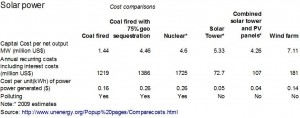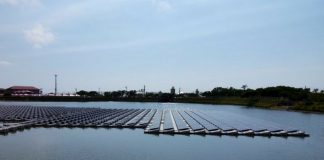http://www.dnaindia.com/money/comment-there-s-nothing-like-the-sun-by-far-1312617
Solar Power: the great awakening
One has only to visit the main portal of the Desertec Foundation (http://www.desertec.org/en/foundation/) to appreciate the staggering consequences of solar power. Blazoned right at the top is the statement, “Within six hours deserts receive more energy from the sun than humankind consumes within a year (see pix).
 Solar power was always reckoned to be an interesting source of power. But there were two problems. First, the problem of being able to convert barely 17% of the suns energy though photo-voltaic (PV) route. The second was the high cost of storing this energy – batteries are still very very expensive – to take care of power needs when the sun is not shining either at night, or during days when the skies are overcast.
Solar power was always reckoned to be an interesting source of power. But there were two problems. First, the problem of being able to convert barely 17% of the suns energy though photo-voltaic (PV) route. The second was the high cost of storing this energy – batteries are still very very expensive – to take care of power needs when the sun is not shining either at night, or during days when the skies are overcast.
These two factors alone caused the installation cost of solar power soar to over Rs.15 crore per MW. But then several things caused the limitations to get pushed aside. First, was the desperate need for the world to move beyond the Damocles sword of both higher fossil fuel prices on the one hand and the danger of global warming caused by fossil fuel emissions on the other. Then came another breakthrough where scientists discovered a better way to generate power through steam from a boiler heated by concentrated solar power focussed by an array of mirrors. This steam generated power was in no way inferior to the steam generated through coal fed boilers which ran turbines in conventional power stations. Innovations from companies like Skyfuel further helped reduce the cost of expensive curved glass mirrors by replacing them with thin reflective low-cost film.
The third breakthrough came in the discovery that energy could be stored in molten salt (actually a fertiliser brew of sodium nitrate and potassium nitrate) at ambient temperature which can store heat for long periods and melts at 200 degrees centigrade and remains in its liquid form throughout its working cycle. While work on this technology is still underway, this could allow entrepreneurs to reduce the cost of setting up solar power stations to almost one-third the earlier estimates (see table)
It is these factors that propelled a company like BrightSource towards financial closure in March this year, for generating 2,600 MW of solar power from the Mojave Desert of California, USA.
Buoyed by this development, Munich Re (the German insurance re-financing giant) announced in July this year the signing of a Memorandum of Understanding in Munich to establish Desertec Industrial Initiative (DII) headquartered in Hamburg. DII will “analyse and develop the technical, economic, political, social and ecological framework for carbon-free power generation in the deserts of North Africa”. Signatories to the DII include ABB, Abengoa Solar, Cevital, Deutsche Bank, E-ON, HSH Nordbank, MAN Solar Millennium, Münchener Rück, M+W Zander, RWE, Schott Solar and Siemens. This project, once it completes its feasibility study by the end of this year, is expected to lead to the setting up a solar power generation facility to generate a whopping 80,000 MW of power.
Significantly, the Desertec Foundation makes mention of India’s Thar desert as a great place to have such a project. It is sparsely populated and has excellent sunshine all round the year.
Suddenly the economics begin to make sense. While conventional power companies are unwilling to comment on the cost of generating solar power, some independent companies have already come up with their calculations (http://www.unenergy.org/Popup%20pages/Comparecosts.html). While solar power is expected to cost a bit more than conventional thermal power stations on a per MW generated basis (in sharp contrast to per MW of installed capacity) – without taking into account the lowered costs through the use of the molten salt technology — it is certainly less expensive than hydro power and wind power. The time to set up a solar plant compares well with that for either thermal or wind power plants. Hydro power plants, in contrast, can take several years to set up. And, most importantly, the cost of generating per unit (kWh) of power is almost one-third of what conventional thermal plants cost.
The power sector across the world is in for dramatic changes. This could have a significant impact on the cost of coal and oil, as well as the operational efficiencies of conventional power plants.











































COMMENTS